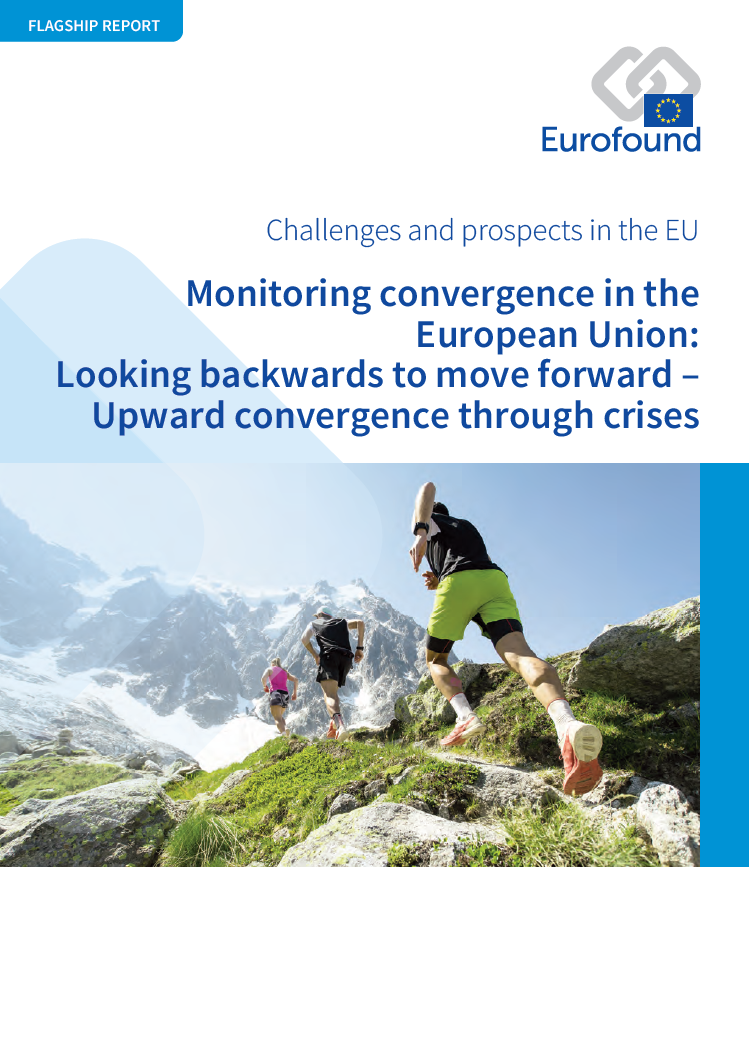
Aufwärtskonvergenz bildet den Kern des Projekts Europäische Union. Die Mitgliedstaaten und ihre Bürger schließen sich der Union an, weil sie sich von ihrer Mitgliedschaft erwarten, dass sie zu ausgewogenem wirtschaftlichen Wohlstand und zu sozialem Fortschritt in den Ländern führt. Zunehmende Ungleichheiten zwischen den Mitgliedstaaten, wie sie in der Wirtschaftskrise 2008-2013 zu beobachten waren, könnten als Verrat und als Nichteinhaltung des Versprechens der EU gesehen werden und die Voraussetzungen für Unmut und Zerfall schaffen. Dieser richtungsweisende Bericht ist der krönende Abschluss der Forschungsarbeiten von Eurofound im Bereich der Beobachtung der Konvergenz in der EU, die 2017 anliefen. Er beschreibt die sich verändernde Dynamik der Aufwärtskonvergenz im Zeitraum 2008-2019, beleuchtet die kurzfristigen Auswirkungen von COVID-19 auf die europäischen Volkswirtschaften und Gesellschaften zusammen mit ihren Folgen für die Konvergenz und erörtert die langfristigen Auswirkungen der Pandemie sowie die Zukunft der wirtschaftlichen und sozialen Aufwärtskonvergenz in Europa.
Key findings
Die Wirtschaftskrise (2008-2013) hatte erhebliche negative Auswirkungen auf die Aufwärtskonvergenz in den EU-Mitgliedstaaten. Während die wirtschaftliche Konvergenz schnell wiederhergestellt wurde, hielt die Abwärtsdivergenz in den Bereichen Beschäftigung und Lebensbedingungen bis 2013 an, was deutlich macht, wie eng verwoben soziale und wirtschaftliche Konvergenz tatsächlich sind.
Während viele sozialpolitische Indikatoren in der Erholungsphase 2014-2019 wieder zusammenzulaufen begannen, hinterließ die Wirtschaftskrise ein uneinheitliches geografisches Erbe. Während Mittel- und Osteuropa sich weiterhin stark der führenden Nordwestregion annäherte, geriet Südeuropa sowohl in sozialer als auch in wirtschaftlicher Hinsicht zunehmend ins Hintertreffen.
Zwischen 2008 und 2019 fehlte es weitgehend an einer Aufwärtskonvergenz hinsichtlich der Qualität von Governance und Institutionen zwischen den EU-Mitgliedstaaten. Vor dem Hintergrund der COVID-19-Krise wird die Konvergenz hinsichtlich der institutionellen Qualität einen wichtigen Beitrag dazu leisten, wirtschaftliche Konvergenz in dauerhafte soziale Konvergenz in Osteuropa umzusetzen und in Südeuropa beide zu verbessern.
Dank der konsequenten politischen Reaktionen auf die Pandemie auf EU- und nationaler Ebene konnten noch verheerendere und ungleichmäßigere Auswirkungen der Krise auf die Arbeitsmärkte in der EU und auf die Lebensbedingungen verhindert werden. Da die COVID-19-Krise jedoch noch nicht vollständig ausgestanden ist, wird es entscheidend sein, diese politischen Bemühungen aufrechtzuerhalten, insbesondere im Zusammenhang mit dem Übergang zu einer digitalen und grünen Wirtschaft, bei dem die richtigen politischen Instrumente von entscheidender Bedeutung sein werden, um zu verhindern, dass sich der Nordosten und der Südwesten erneut auf den Divergenzpfad begeben.
Die vollständige Umsetzung der Pläne im Zusammenhang mit NextgenerationEU wird unerlässlich sein, und die Konvergenz zwischen den EU-Mitgliedstaaten wird davon abhängen, wie gut die nationalen Konjunkturprogramme mit dem Leitbild auf EU-Ebene in Einklang stehen. Die Bereitschaft der Regierungen, sich auf supranationale Prioritäten auszurichten, ist eine gute Gelegenheit, die durch die COVID-19-Pandemie entstandenen Ungleichheiten umzukehren, und dabei wird die Koordination auf EU-Ebene von ganz besonderer Bedeutung sein.
The flagship report contains the following list of tables and figures.
List of tables
Table 1: Overview of indicators
Table 2: Drivers of employment in the EU (panel analysis)
Table 3: Drivers of employment growth in the EU (panel analysis)
Table 4: Summary of economic convergence trends in sigma, delta and beta convergence and at the regional level
Table 5: Summary of social convergence trends in sigma, delta and beta convergence and at the regional level
Table 6: Summary of institutional convergence trends in sigma, delta and beta convergence
Table A1: Drivers of employment in the EU (panel analysis)
Table A2: Drivers of employment growth in the EU (panel analysis)
Table A3: Impact of unemployment changes on GDP per capita (regression coefficients), EU27, 2000–2019
List of figures
Figure 1: The three dimensions of convergence
Figure 2: Sigma and delta convergence in GDP per capita (PPS), EU27, 2008–2019
Figure 3: Unconditional beta convergence in GDP per capita (PPS), EU27, 2008–2019
Figure 4: Regional quintile clusters of GDP per capita in PPS in 2008 and 2019 and cluster mobility from 2008 to 2019, EU NUTS 2
Figure 5: Sigma and delta convergence in disposable household income per capita (PPS), 2008–2019
Figure 6: Unconditional beta convergence in disposable household income per capita (PPS), 2008–2019
Figure 7: Regional quintile clusters of disposable household income per capita in PPS in 2008 and 2019 and cluster mobility from 2008 to 2019, EU NUTS 2
Figure 8: Sigma and delta convergence in income inequality (income quintile share ratio), EU27, 2008–2019
Figure 9: Unconditional beta convergence in income inequality (income quintile share ratio), EU27, 2008–2019
Figure 10: Sigma and delta convergence in monthly minimum wage (PPS), 2008–2019
Figure 11: Unconditional beta convergence in monthly minimum wage (PPS), 2008–2019
Figure 12: Sigma and delta convergence in the employment rate (%), EU27, 2008–2019
Figure 13: Unconditional beta convergence in the employment rate (%), EU27, 2008–2013 and 2013–2019
Figure 14: Regional quintile clusters of the employment rate in 2008 and 2019 and cluster mobility from 2008 to 2019, EU NUTS 2
Figure 15: Sigma and delta convergence in the unemployment rate (%), EU27, 2008–2019
Figure 16: Unconditional beta convergence in the unemployment rate (%), EU27, 2008–2013 and 2013–2019
Figure 17: Regional quintile clusters of the unemployment rate in 2008 and 2019 and cluster mobility from 2008 to 2019, EU NUTS 2
Figure 18: Sigma and delta convergence in the gender employment gap (%), EU27, 2008–2019
Figure 19: Unconditional beta convergence in the gender employment gap (%), EU27, 2008–2019
Figure 20: Regional quintile clusters of the gender employment gap in 2008 and 2019 and cluster mobility from 2008 to 2019, EU NUTS 2
Figure 21: Sigma and delta convergence in the youth NEET rate (%), EU27, 2008–2019
Figure 22: Unconditional beta convergence in the youth NEET rate (%), EU27, 2008–2013 and 2013–2019
Figure 23: Regional quintile clusters of the youth NEET rate in 2008 and 2019 and cluster mobility from 2008 to 2019, EU NUTS 2
Figure 24: Sigma and delta convergence in the early school leavers rate (%), EU27, 2008–2019
Figure 25: Unconditional beta convergence in the early school leavers rate (%), EU27, 2008–2019
Figure 26: Regional quintile clusters of the early school leavers rate in 2008 and 2019 and cluster mobility from 2008 to 2019, EU NUTS 2
Figure 27: Sigma and delta convergence in the AROPE rate (%), EU27, 2008–2019
Figure 28: Unconditional beta convergence in the AROPE rate (%), EU27, 2008–2013 and 2013–2019
Figure 29: Sigma and delta convergence in unmet medical needs (%), EU27, 2008–2019
Figure 30: Unconditional beta convergence in unmet medical needs (%), EU27, 2008–2019
Figure 31: Sigma and delta convergence in the WGI rule of law, EU27, 2008–2019
Figure 32: Unconditional beta convergence in the WGI rule of law, EU27, 2008–2019
Figure 33: Sigma and delta convergence in the WGI government effectiveness, EU27, 2008–2019
Figure 34: Unconditional beta convergence in the WGI government effectiveness, EU27, 2008–2019
Figure 35: Sigma and delta convergence in the WGI regulatory quality, EU27, 2008–2019
Figure 36: Unconditional beta convergence in the WGI regulatory quality, EU27, 2008–2019
Figure 37: Sigma and delta convergence in the WGI voice and accountability, EU27, 2008–2019
Figure 38: Unconditional beta convergence in the WGI voice and accountability, EU27, 2008–2019
Figure 39: Sigma and delta convergence in the WGI control of corruption, EU27, 2008–2019
Figure 40: Unconditional beta convergence in the WGI control of corruption, EU27, 2008–2019
Figure 41: Sigma and delta convergence in the Ease of Doing Business score, EU27, 2010–2019
Figure 42: Unconditional beta convergence in the Ease of Doing Business score, EU27, 2010–2019
Figure 43: Regional clusters of the European Quality of Government Index score (EQI), EU NUTS 1 and 2, 2010 and 2017
Figure 44: Employment rates in the previous year and annual growth rates by EU Member State, 2000–2019
Figure 45: Employment growth in southern and central and eastern countries relative to western/northern Europe (regression coefficients plot)
Figure 46: Summary of the regional leaders and laggards in the social dimension and cluster mobility in the economic dimension, EU NUTS 2, 2008–2019
Figure 47: Relationship between GDP and unemployment in 2008–2009 (growth rates), EU27
Figure 48: Relationship between GDP and unemployment in 2019–2020 (growth rates), EU27
Figure 49: Actual versus predicted unemployment rate in 2020 (%), EU27
Figure 50: SURE loans and the unemployment gap in 2020, EU27
Figure 51: Unweighted average employment rate and projections to meet the European Pillar of Social Rights Action Plan 2030 target (%), EU27
Figure 52: Unweighted average youth NEET rate and projections to meet the European Pillar of Social Rights Action Plan 2030 target (%), EU27
Figure 53: Sigma convergence in GDP per capita (PPS), EU27, 2013–2020
Figure 54: Change in GDP per capita (in PPS) by Member State (%), EU27, 2019–2020
Figure 55: Unconditional beta convergence in GDP per capita (PPS), EU27, 2019–2020
Figure 56: Percentage change in GDP per capita (in PPS), EU27, 2019–2020
Figure 57: Sigma convergence in the unemployment rate (%), EU27, 2013–2021 (monthly data: January 2020–May 2021)
Figure 58: Change in unemployment rate by Member State (percentage points), EU27, 2019–2020
Figure 59: Unconditional beta convergence of the unemployment rate (%), EU27, 2019–2020
Figure 60: Percentage point change in the unemployment rate, EU NUTS 2, 2019–2020
Figure 61: Sigma convergence in the activity rate (%), EU27, 2013–2020 (quarterly data: Q4 2019–Q4 2020)
Figure 62: Sigma convergence in labour market slack (%), EU27, 2013–2020 (quarterly data: Q4 2019–Q4 2020)
Figure 63: Unconditional beta convergence in labour market slack (%), EU27, 2019–2020
Figure 64: Estimated change in the at-risk-of-poverty rate, EU, 2019–2020
Figure 65: Sigma convergence in the youth NEET rate (%), EU27, 2013–2020 (quarterly data: Q4 2019–Q4 2020)
Figure 66: Unconditional beta convergence in the youth NEET rate (%), EU27, 2019–2020
Figure 67: Degree of plausibility (on a scale of 1–10) of the health recovery scenarios as assessed by Eurofound experts
Figure 68: Possible economic recovery scenarios
Figure 69: Expected speed of economic recovery, EU27
Figure 70: Experts’ opinions on the expected economic crisis triggered by the COVID-19 pandemic (on a scale of 0–100)
- Number of pages
-
120
- Reference nº
-
EF21008
- ISBN
-
978-92-897-2237-7
- Catalogue nº
-
TJ-01-21-504-EN-N
- DOI
-
10.2806/78744
- Permalink
Cite this publication
Eurofound (2021), Monitoring convergence in the European Union: Looking backwards to move forward – Upward convergence through crises, Challenges and prospects in the EU series, Publications Office of the European Union, Luxembourg.
